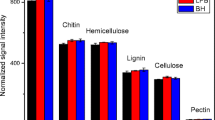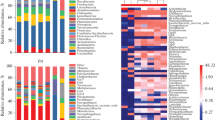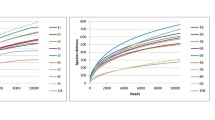Abstract
Activated sludge system is an important process of domestic and industrial wastewater treatment containing highly diverse microbial communities. In this study, high-throughput sequencing was applied to examine the microbial community composition and diversity of activated sludge samples from four full-scale municipal wastewater treatment plants (WWTPs) in Shanghai. A relationship between microbial communities and environmental variables was examined. Proteobacteria was the most dominant phylogenetic group, followed by Bacteroidetes and Firmicutes. A total of 166 genera were commonly shared by all seven sludge samples, including Zoogloea, Dechloromonas, Thauera, Nitrospira, Arcobacter, etc. Besides these shared populations, certain unique bacterial populations were found abundant in individual sludge sample. Canonical correspondence analysis (CCA) indicated that influent COD and pH had the greatest influence on microbial community compositions, whereas dissolved oxygen (DO) exhibited the least influence. The operating process was likely to foster diversity of the microbial communities inhabiting the wastewater treatment facilities. Alternative operation methods including a fluctuation of anoxic, oxic, and anaerobic conditions were favorable for promoting the growth of diverse microbial populations in activated sludge systems.






Similar content being viewed by others
References
Briones A, Raskin L (2003) Diversity and dynamics of microbial communities in engineered environments and their implications for process stability. Curr Opin Biotech 14(3):270–276
Caporaso JG, Lauber CL, Walters WA, Berg-Lyons D, Lozupone CA, Turnbaugh PJ, Fierer N, Knight R (2011) Global patterns of 16S rRNA diversity at a depth of millions of sequences per sample. P Natl Acad Sci USA 108(Supplement 1):4516–4522
Chinese NEPA (2012) Water and wastewater monitoring methods, 4th edn. Chinese Environmental Science Publishing House, Beijing, China
Crossman LC, Chen H, Cerdeño-Tárraga A-M, Brooks K, Quail MA, Pineiro SA, Hobley L, Sockett RE, Bentley SD, Parkhill J, Williams HN, Stine OC (2013) A small predatory core genome in the divergent marine Bacteriovorax marinus SJ and the terrestrial Bdellovibrio bacteriovorus. ISME J 7(1):148–160
Dias FF, Bhat JV (1964) Microbial ecology of activated sludge I. dominant bacteria. Appl Microbiol 12(5):412–417
Fierer N, Jackson RB (2006) The diversity and biogeography of soil bacterial communities. P Natl Acad Sci USA 103(3):626–631
Foesel BU, Rohde M, Overmann J (2013) Blastocatella fastidiosa gen. nov., sp. nov., isolated from semiarid savanna soil—the first described species of acidobacteria subdivision 4. Syst Appl Microbiol 36(2):82–89
Fuchs G, Boll M, Heider J (2011) Microbial degradation of aromatic compounds—from one strategy to four. Nat Rev Microbiol 9(11):803–816
van der Gast CJ, Ager D, Lilley AK (2008) Temporal scaling of bacterial taxa is influenced by both stochastic and deterministic ecological factors. Environ Microbiol 10(6):1411–1418
Ginige MP, Hugenholtz P, Daims H, Wagner M, Keller J, Blackall LL (2004) Use of stable-isotope probing, full-cycle rRNA analysis, and fluorescence in situ hybridization-microautoradiography to study a methanol-fed denitrifying microbial community. Appl Environ Microb 70(1):588–596
Ibarbalz FM, Figuerola ELM, Erijman L (2013) Industrial activated sludge exhibit unique bacterial community composition at high taxonomic ranks. Water Res 47(11):3854–3864
Juretschko S, Loy A, Lehner A, Wagner M (2002) The microbial community composition of a nitrifying-denitrifying activated sludge from and industrial sewage treatment plant analyzed by the full-cycle rRNA approach. Syst Appl Microbiol 25(1):84–99
Kim B-C, Kim S, Shin T, Kim H, Sang B-I (2013a) Comparison of the bacterial communities in anaerobic, anoxic, and oxic chambers of a pilot A2O process using pyrosequencing analysis. Curr Microbiol 66(6):555–565
Kim T-S, Jeong J-Y, Wells GF, Park H-D (2013b) General and rare bacterial taxa demonstrating different temporal dynamic patterns in an activated sludge bioreactor. Appl Microbiol Biot 97(4):1755–1765
Kragelund C, Levantesi C, Borger A, Thelen K, Eikelboom D, Tandoi V, Kong Y, Krooneman J, Larsen P, Thomsen TR, Nielsen PH (2008) Identity, abundance and ecophysiology of filamentous bacteria belonging to the Bacteroidetes present in activated sludge plants. Microbiology 154(3):886–894
Krzywinski M, Schein J, Birol I, Connors J, Gascoyne R, Horsman D, SJ J, MA M (2009) Circos: an information aesthetic for comparative genomics. Genome Res 19(9):1639–1645
Lepš J, Šmilauer P (2003) Multivariate analysis of ecological data using CANOCO. Cambridge University Press, Cambridge
Limpiyakorn T, Sonthiphand P, Rongsayamanont C, Polprasert C (2011) Abundance of amoA genes of ammonia-oxidizing archaea and bacteria in activated sludge of full-scale wastewater treatment plants. Bioresource Technol 102(4):3694–3701
Liu B, Zhang F, Feng X, Liu Y, Yan X, Zhang X, Wang L, Zhao L (2006) Thauera and Azoarcus as functionally important genera in a denitrifying quinoline-removal bioreactor as revealed by microbial community structure comparison. FEMS Microbiol Ecol 55(2):274–286
Liu Y, Zhang T, Fang HHP (2005) Microbial community analysis and performance of a phosphate-removing activated sludge. Bioresource Technol 96(11):1205–1214
Ma Q, Qu YY, Shen WL, Zhang ZJ, Wang JW, Liu ZY, Li DX, Li HJ, Zhou JT (2015) Bacterial community compositions of coking wastewater treatment plants in steel industry revealed by Illumina high-throughput sequencing. Bioresource Technol 179:436–443
McKinney RE, Weichlein RG (1953) Isolation of floc-producing bacteria from activated sludge. Appl Microbiol 1(5):259–261
Miura Y, Hiraiwa MN, Ito T, Itonaga T, Watanabe Y, Okabe S (2007a) Bacterial community structures in MBRs treating municipal wastewater: relationship between community stability and reactor performance. Water Res 41(3):627–637
Miura Y, Watanabe Y, Okabe S (2007b) Significance of Chloroflexi in performance of submerged membrane bioreactors (MBR) treating municipal wastewater. Environ Sci Technol 41(22):7787–7794
Phillips CA (2001) Arcobacters as emerging human foodborne pathogens. Food Control 12(1):1–6
Pholchan MK, Baptasta JC, Davenport RJ, Curtis TP (2010) Systematic study of the effect of operating variables on reactor performance and microbial diversity in laboratory-scale activated sludge reactors. Water Res 44(5):1341–1352
Reinhold-Hurek B, Hurek T (2006) The genera Azoarcus, Azovibrio, Azospira and Azonexus. The Prokaryotes, Volume 5: Proteobacteria: Alpha and Beta Subclasses. Springer, New York, pp. 873–891
Roesch LFW, Fulthorpe RR, Riva A, Casella G, Hadwin AKM, Kent AD, Daroub SH, Camargo FAO, Farmerie WG, Triplett EW (2007) Pyrosequencing enumerates and contrasts soil microbial diversity. ISME J 1(4):283–290
Snaidr J, Amann R, Huber I, Ludwig W (1997) Phylogenetic analysis and in situ identification of bacteria in activated sludge. Appl Environ Microb 63(7):2884–2896
Spain AM, Krumholz LR, Elshahed MS (2009) Abundance, composition, diversity and novelty of soil Proteobacteria. ISME J 3(8):992–1000
Sun M, Xiao TF, Ning ZP, Xiao EN, Sun WM (2015a) Microbial community analysis in rice paddy soils irrigated by acid mine drainage contaminated water. Appl Microbiol Biot 99(6):2911–2922
Sun WM, Dong YR, Gao P, Fu MY, Ta KW, Li JW (2015c) Microbial communities inhabiting oil-contaminated soils from two major oilfields in northern China: implications for active petroleum-degrading capacity. J Microbiol 53(6):371–378
Sun WM, Xiao TF, Sun M, Dong YR, Ning ZP, Xiao EN, Tang S, Li JW (2015b) Diversity of the sediment microbial community in the Aha watershed (southwest China) in response to acid mine drainage pollution gradients. Appl Environ Microb 81(15):4874–4884
Wagner M, Loy A (2002) Bacterial community composition and function in sewage treatment systems. Curr Opin Biotech 13(3):218–227
Wang XH, Hu M, Wen XH, Ding K (2012) Pyrosequencing analysis of bacterial diversity in 14 wastewater treatment systems in China. Appl Environ Microb 78(19):7042–7047
Wells GF, Park H-D, Eggleston B, Francis CA, Criddle CS (2011) Fine-scale bacterial community dynamics and the taxa-time relationship within a full-scale activated sludge bioreactor. Water Res 45(17):5476–5488
Wells GF, Park H-D, Yeung C-H, Eggleston B, Francis CA, Criddle CS (2009) Ammonia-oxidizing communities in a highly aerated full-scale activated sludge bioreactor: Betaproteobacterial dynamics and low relative abundance of Crenarchaea. Environ Microbiol 11(9):2310–2328
Xia SQ, Duan L, Song YH, Li JX, Piceno YM, Andersen GL, Alvarez-Cohen L, Moreno-Andrade I, Huang CL, Hermanowicz SW (2010) Bacterial community structure in geographically distributed biological wastewater treatment reactors. Environ Sci Technol 44(19):7391–7396
Xia Y, Wang XH, Wen XH, Ding K, Zhou JZ, Yang YF, Zhang Y (2014) Overall functional gene diversity of microbial communities in three full-scale activated sludge bioreactors. Appl Microbiol Biot 98(16):7233–7242
Xiong JB, Liu YQ, Lin XG, Zhang HY, Zeng J, Hou JZ, Yang YP, Yao TD, Knight R, Chu HY (2012) Geographic distance and pH drive bacterial distribution in alkaline lake sediments across Tibetan plateau. Environ Microbiol 14(9):2457–2466
Yang C, Zhang W, Liu RH, Li Q, Li BB, Wang SF, Song CJ, Qiao CL, Mulchandani A (2011) Phylogenetic diversity and metabolic potential of activated sludge microbial communities in full-scale wastewater treatment plants. Environ Sci Technol 45(17):7408–7415
Yao YL, Guan J, Tang P, Jiao HP, Lin C, Wang JJ, Lu ZM, Min H, Gao HC (2010) Assessment of toxicity of tetrahydrofuran on the microbial community in activated sludge. Bioresource Technol 101(14):5213–5221
Yuan Z, Blackall LL (2002) Sludge population optimisation: a new dimension for the control of biological wastewater treatment systems. Water Res 36(2):482–490
Zhang T, Shao MF, Ye L (2012) 454 pyrosequencing reveals bacterial diversity of activated sludge from 14 sewage treatment plants. ISME J 6(6):1137–1147
Zhou Z, Qiao WM, Xing C, An Y, Shen XL, Ren WC, Jiang LM (2015) Microbial community structure of anoxic-oxic-settling-anaerobic sludge reduction process revealed by 454-pyrosequencing. Chem Eng J 266:249–257
Zhou Z, Qiao WM, Xing C, Shen XL, Hu DL, Wang LC (2014) A micro-aerobic hydrolysis process for sludge in situ reduction: performance and microbial community structure. Bioresource Technol 173:452–456
Author information
Authors and Affiliations
Corresponding authors
Ethics declarations
Funding
This study was funded by the National Natural Science Foundation of China (51178093, 51208086), the Shanghai Pujiang Program (13PJ1400100), the DHU Distinguished Young Professor Program, and the Fundamental Research Funds for the Central Universities.
Rights and permissions
About this article
Cite this article
Gao, P., Xu, W., Sontag, P. et al. Correlating microbial community compositions with environmental factors in activated sludge from four full-scale municipal wastewater treatment plants in Shanghai, China. Appl Microbiol Biotechnol 100, 4663–4673 (2016). https://doi.org/10.1007/s00253-016-7307-0
Received:
Revised:
Accepted:
Published:
Issue Date:
DOI: https://doi.org/10.1007/s00253-016-7307-0




